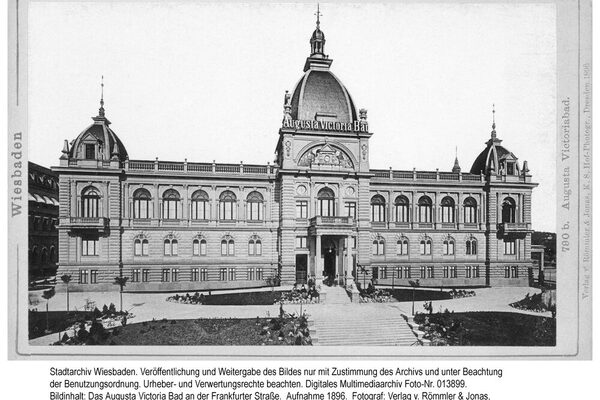Augusta-Victoria-Bath
In 1889, the architect Louis Modrow from Frankfurt am Main was commissioned to build a luxury hotel on the corner of Frankfurter Strasse and Viktoriastrasse, which was to include a public indoor swimming pool. However, payment difficulties led to bankruptcy as early as 1892. In 1893, the Frankfurt building contractor Philipp Helfmann bought the shell of the building at auction and had the hotel and swimming pool completed by the Berlin architect Ludwig Helm.
On March 14, 1895, the Hotel Kaiserhof, a luxury hotel with 160 beds, and the Augusta-Victoria-Bad were officially opened. The spa, named after the wife of Wilhelm II, was an elongated building in the neo-Renaissance style. It had two inner courtyards and was crowned by three domes. It was connected to the Hotel Kaiserhof by two covered and heated corridors.
The area reserved for hotel guests drew its water from a thermal spring on Spiegelgasse, while the public part of the baths was fed from the municipal water supply and a spring on the Erbenheimer Höhe.
During the First World War, the Kaiserhof became a reserve hospital, and in 1938 the military district administration XII, the district administration of the Reich Labour Service Hesse-South and the offices of the "Organization Todt" moved in. The baths finally became a public facility and became the property of the city of Wiesbaden in 1939.
During the bombing raid on Wiesbaden in February 1945, the Hotel Kaiserhof and the August-Victoria-Bad were destroyed and never rebuilt.
Literature
Spiegel, Margit: Wiesbadener Firmenbriefköpfe aus der Kaiserzeit 1871-1914. Fabrik- und Hotelansichten auf Geschäftsschreiben und Rechnungen. 50 examples with brief company portraits, vol. 1, Wiesbaden 2003 [pp. 96-98].
